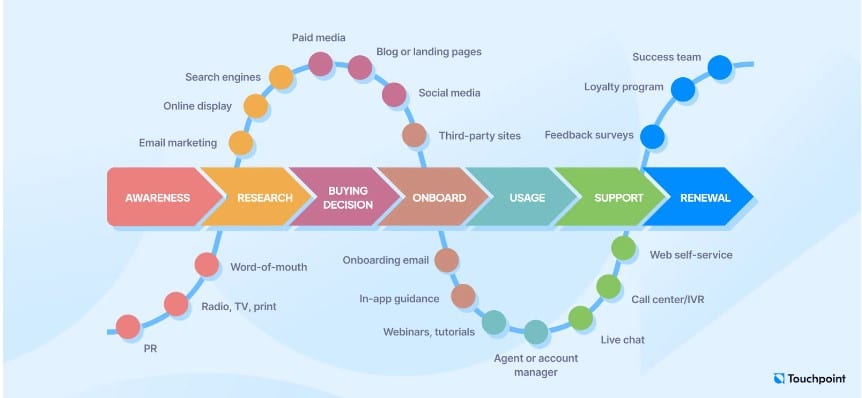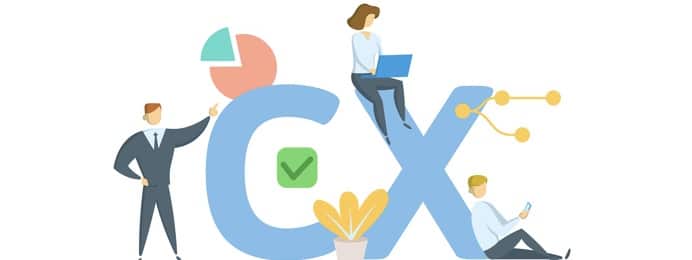A customer experience (CX) platform is the sum of any tool or technology used to help a company manage customer interactions across various touchpoints to improve customer service.
These touchpoints could be online (social media, email marketing, and the website) or offline (physical store and print advertising.)
This blog explains everything you need to know about CX platforms. We’ll cover the following points:
- Why does a company need a CX platform?
- How are different customer touchpoints categorized?
- What are the key features of a CX platform?
- How can a company select a CX platform?

Why does a company need a CX platform?
Customers are the lifeblood of a business. Without customers, there is no business. Naturally, managing customer relationships should be high on any brand’s priority list.
Customer experience management software helps a business process the entire customer journey across all touchpoints to create positive customer experiences.

The benefits of a CX platform include:
- Improved customer satisfaction through data collection. The data is used to provide a personalized experience at every touchpoint.
- Streamline customer support. As a business grows, it’s not always feasible to ask customers to send an email with any queries. The quantity, diversity, and sentiment of customer inquiries demand a contact center that can arrange, segment, and prioritize them to manage customer expectations.
- Omnichannel engagement. Instead of manually setting up customer touchpoints at every channel (online and offline), the CX system integrates all of them in a unified manner.
- Through data collection, a brand learns valuable insights about its customer’s needs and can start proactively engaging with them, which is conducive to customer loyalty and retention.
How are different customer touchpoints categorized?
We briefly touched on online and offline touchpoints. In CX, touchpoints are further categorized to create three customer segments.
- Pre-purchase touchpoints are any company interaction with a customer before purchase, such as online or offline ads and organic content on the website and social media.
- Purchase touchpoints are interactions at the time of purchase, such as the e-commerce section of a website, a mobile app, a physical store, or through direct contact with a sales team.
- Post-purchase touchpoints cover everything after an offline or e-commerce conversion, such as post-purchase support, delivery and shipping communications, feedback and surveys, billing and invoices, and returns and exchanges.
The touchpoints are arranged chronologically (from the point of interest in a product to after-sales support) because they help a company devise robust customer experience strategies.

Now, let’s look at an example.
At the pre-purchase level, a company can understand customer needs, desires, pain points, and the factors that positively and negatively impact purchasing decisions.
The company uses the data to formulate actionable insights that feed into its marketing campaign (blog posts, social media content, and ads). Subsequently, each marketing piece is geared to empathize with and acknowledge their needs and pre-emptively address any customer objections to maximize the chances of a sale.
Any customer reaching the purchase touchpoint means they genuinely need the company’s product or services. So, you need a website.
That’s where an easy-to-use website builder comes into play. It’s designed to simplify the website creation process so you can build without relying on designers or developers. You can create a website that’s user-friendly for all devices, improving your user experience and reducing barriers by optimizing digital experiences.

Sometimes, customers add items to their basket and do not finish their purchase. A CX enables a company to identify cart abandonment instantly to gain real-time insights and analyze the reason for this customer behavior to improve the purchase touchpoint. Then, the company can send them a retargeting email or a voucher to incentivize the purchase.
If a customer goes ahead with a purchase, a company wants to ensure that the customer is happy with the purchase and wants to convert them into a repeat customer. Here’s where the after-sales support and communication kicks in.
If a customer is unhappy with a purchase, the company seeks to understand why and uses this data to make relevant changes to any of the three touchpoints.
As a result, the three touchpoints are a continuous loop of information, gathering direct and indirect customer feedback and iteratively improving the touchpoint to improve customer relationship management.
Key features of a CX system
Every CX system will have slightly different features. Some of the standout features include:
- A customer relationship management (CRM) system that stores all customer information in a single place, including detailed customer profiles and historical communications the customer had with the company.
- Tools to design and distribute customer surveys and collect feedback from customers and customer reviews left elsewhere (Trustpilot, Google Reviews.)
- Data visualization highlights historical trends and generates custom reports that provide insights into customer behavior. The data can be interpreted to identify and implement new customer experience solutions. It can also be used to accurately predict future customer trends, which can inform future marketing and content strategies.
- The integration of multiple customer communication channels (such as email, IM, social media, phone, etc.) into one interface. For example, employee communication apps boost how well you serve your customers. When your team can easily stay in touch and share info, they’re better equipped to help your customers.
- Automation and workflow management, where answers to common customer queries are responded to by artificial intelligence (AI) like AI chatbots and the general automation of repetitive tasks such as following up with customers post-purchase. This frees up a human agent’s time for more strategic customer engagement work.
How does a company select a CX platform?
Before investing in a customer data platform, consider the following factors:
- Ensuring the platform helps a company meet its objective. For example, if a company lacks customer support, it should prioritize a CX with a solid customer support system and social listening features to proactively meet customer needs.
- How easy is the CX to use? Does it come with a robust training and support system?
- Integration needs. Does the CX seamlessly integrate with a company’s legacy systems?
- Does the CX platform integrate with your current tech stack?
- Does the CX have a mobile-friendly interface?
- Can the CX scale as the company scales?
- Will the CX keep customer data safe?
- Is the CX in the budget?
Wrapping up
CX is a single platform with a suite of tools for modern businesses seeking a competitive edge.
A CX tool can help a company manage the entire customer lifecycle, improving offline and digital experiences at every touchpoint.
The ability to proactively address customer needs, enhance satisfaction, and build long-term loyalty underscores the critical role of CX platforms in supporting customer service teams to drive business success.
As customer expectations evolve, adopting a robust CX platform ensures companies remain agile, responsive, and well-positioned to deliver exceptional customer experiences.








